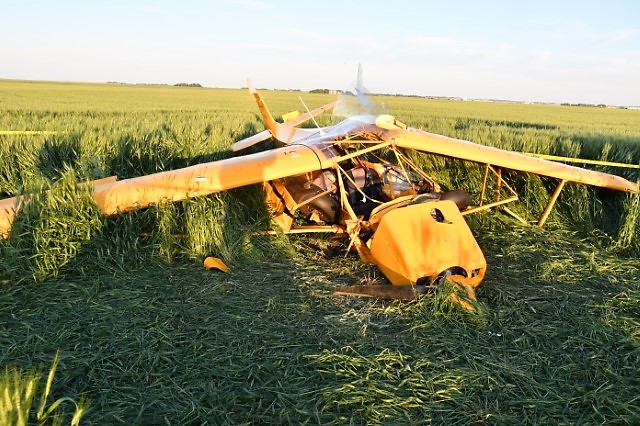Collision with terrain
Privately registered
Zlin Aviation s.r.o. Savage Cub (advanced ultralight), C-IILH
Didsbury, Alberta, 7 NM E
The Transportation Safety Board of Canada (TSB) investigated this occurrence for the purpose of advancing transportation safety. It is not the function of the Board to assign fault or determine civil or criminal liability. This report is not created for use in the context of legal, disciplinary or other proceedings. See Ownership and use of content. Masculine pronouns and position titles may be used to signify all genders to comply with the Canadian Transportation Accident Investigation and Safety Board Act (S.C. 1989, c. 3).
History of the flight
At approximately 0955Footnote 1 on 13 July 2022, the privately registered Zlin Aviation s.r.o. (Zlin) Savage Cub advanced ultralight aircraft (registration C-IILH, serial number 0170) departed a private airstrip approximately 7 nautical miles (NM) east of Didsbury, Alberta, for a local recreational flight with the owner/pilot and a passenger on board.
The flight was conducted within 4 NM of the private airstrip at various altitudes up to approximately 1100 feet above ground level (AGL). Details of the flight path were captured by a portable GPS (global positioning system).Footnote 2
In addition, the investigation obtained a smartphone video of the last minute of the flight recorded from inside the aircraft. The video captured the aircraft entering an intentional power-on stall at 1100 feet AGL. A successful recovery was made followed by a transition into another power-on stall at 900 feet AGL with a steeper nose-up attitude. At the point of the stall when the nose dropped, the left wing dropped as well, and the aircraft entered a left spin. Power was reduced to idle, increased momentarily, and then reduced to idle again.
During the spin, the pilot held the flight control stick aft and to the right. On 2 occasions, the controls were moved to a neutral position for less than 1 second each time before returning to the aft and right control position (Figure 1).
|
The aircraft’s average descent rate was approximately 3300 fpm and the rate of rotation during the spin was approximately 90° per second. The aircraft’s attitude near the end of the spinning manoeuvre was relatively flat compared to the typical nose-down attitude for light aircraft in a spin (which is normally fairly steep).
The aircraft impacted a field 0.7 NM south of the airstrip at 1014:08. The pilot and passenger received fatal injuries. The aircraft was not equipped with an emergency locator transmitter (ELT), nor was it required to be by regulation.
At approximately 1530, a search was initiated by the pilot’s family, and a local pilot discovered the wreckage at 1630. First responders arrived at the scene at 1715 (7 hours after the accident).
Weather information
The hourly aerodrome routine meteorological report issued at 1000 for Calgary International Airport (CYYC), Alberta, 31 NM south of the accident site, indicated the following: winds from 340° true at 11 knots; visibility 15 statute miles; few clouds at 8000 feet AGL and 16 000 feet AGL; temperature 17° C and dew point 8° C; altimeter setting 29.87 inches of mercury; and density altitude 4700 feet.
Weather was not considered a factor in this occurrence.
Pilot information
The owner/pilot held a pilot permit – ultra-light aeroplane, which was issued on 21 October 2013. It was endorsed with a rating that allowed him to carry passengers. He held a Category 4 medical certificate that was valid until 01 October 2023. The pilot had 449.1 hours total flight time, 430.3 hours of which were on the Zlin Savage Cub.
Aircraft information
The Zlin Savage Cub was registered in Canada as an advanced ultralight aircraft. The aircraft was equipped with fixed, conventional landing gear (tail wheel), a ground adjustable Ivoprop Quick Adjustment Medium composite propeller, and a Rotax 912 ULS piston engine. The occurrence aircraft was manufactured in 2009 in the Czech Republic.
According to the aircraft’s records, it had 1235.1 flight hours total time since new as of June 2022.
The aircraft was within its weight and balance limits during the occurrence flight.
Accident site and wreckage examination
The aircraft struck the ground with little-to-no forward speed in a shallow, nose-down attitude with a slight right-wing-low bank angle. The right main gear was pushed up into the aft cabin area. The left main gear was bent to the left of the fuselage. Both wing struts failed from downward bending, with the left wing tip resting on the ground (Figure 2). Continuity of all flight and engine controls was confirmed.
Spins and stalls
Transport Canada indicates that stall recovery should be completed “at an operationally safe altitude that allows recovery at or above 2000 feet AGL or the minimum height recommended by the manufacturer, whichever is higher.”Footnote 3 The pilot operating handbook for the aircraft states that intentional spins are prohibited.
Emergency locator transmitter
Subsection 605.38(3) of the Canadian Aviation Regulations allows ultralightFootnote 4 aircraft to operate without an ELT on board.
The occurrence pilot used a smartphone application to track his location, and his family had access to the application’s account. Although the application recorded the flight that morning and the last position of the aircraft, it was not used to locate the aircraft.
Safety messages
Pilots are reminded that stalls should be conducted at an altitude from which a safe recovery can be made. When conducting stalls, there is always a possibility that the aircraft will enter an inadvertent spin, so pilots should be familiar with the spin recovery techniques for their aircraft model. In addition, pilots should not conduct stalls when there are passengers on board.
ELTs, even though not required on ultralight aircraft, have the potential to improve the timeliness of locating an aircraft involved in an accident.
This report concludes the Transportation Safety Board of Canada’s investigation into this occurrence. The Board authorized the release of this report on . It was officially released on .
